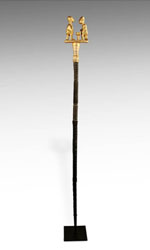Ashanti Orator Staff of Linguist Staff
 |
|
The Ashanti Kingdom is a loose confederation of multiple chiefdoms, each chief having his own royal court with a set of prescribed dignitaries and constituencies. One of the most important dignitaries is the Orator or Linguist. The Orator is to the chief what our Press Secretary is to the President. His job is to clearly repeat the Chief’s remarks at public assemblies and wittily rephrase them in “diplomatic” language. In other words, to rephrase the Chief’s remarks in a way that is palatable to the audience yet at the same time confirms the power of the Chief. The Orator is formally known as the Okyeame.
 |
|
To accomplish his mission the Okyeame engages in a verbal art form, which is the recitation of parables related to the power of the chief. In the Ashanti language there are thousands of parables of this sort. When the Okyeame speaks he carries a staff with a detachable carved top or finial. The most valuable part of the staff is the top, which sculpturally depicts the proverb being referenced. There is enormous diversity in the tops because of the number of proverbs, and these proverbs or sayings may vary from court to court.
For example, a staff top depicting a leopard holding down a porcupine depicts the proverb “Only the leopard knows when the porcupine’s quills are down,” a short commentary on the Chief’s leadership, intuition and powers of observation. A staff top showing one person eating while another looks on would be a reference to one of many proverbs about sharing. A top depicting an elephant might refer to the saying “If there was no elephant the buffalo would be the biggest creature.” This, like many other sayings, means everything is relative, but there is only one chief. In fact, individual staff tops might reference many related proverbs at the same time.
While the woodcarver is main creator of staffs, the
After the staffs were completed they were consecrated before being given to the Orator. Europeans introduced
Download this Article: Ashanti Linguist Staff (Okyeame).pdf